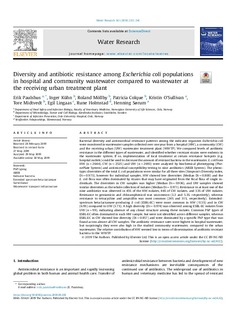| dc.description.abstract | Bacterial diversity and antimicrobial resistance patterns among the indicator organism Escherichia coli were monitored in wastewater samples collected over one year from a hospital (HW), a community (CW) and the receiving urban (UW) wastewater treatment plant (WWTP). We compared levels of antibiotic resistance in the different types of wastewater, and identified whether resistant strains were endemic in the wastewater system. If so, implementation of local treatment at certain resistance hotspots (e.g. hospital outlets) could be used to decrease the amount of resistant bacteria in the wastewater. E. coli from HW (n = 2644), CW (n = 2525) and UW (n = 2693) were analyzed by biochemical phenotyping (PhenePlate System) and antimicrobial susceptibility testing to nine antibiotics (AREB System). The phenotypic diversities of the total E. coli populations were similar for all three sites (Simpson's Diversity index, Di = 0.973), however for individual samples, HW showed low diversities (Median Di = 0.800) and the E. coli flora was often dominated by strains that may have originated from the fecal flora of single individuals. The diversities in CW samples was higher (Median Di = 0.936), and UW samples showed similar diversities as the whole collection of isolates (Median Di = 0.971). Resistance to at least one of the nine antibiotics was observed in 45% of the HW isolates, 44% of CW isolates, and 33% of UW isolates. Resistance to gentamicin and chloramphenicol was uncommon (3.2 and 5.3%, respectively), whereas resistance to tetracycline and ampicillin was most common (24% and 31%, respectively). Extended-spectrum beta-lactamase-producing E. coli (ESBL-EC) were more common in HW (11.5%) and in CW (6.9%) compared to UW (3.7%). A high diversity (Di = 0.974) was observed among ESBL-EC isolates from UW (n = 99), indicating absence of any clonal structure among these isolates. Common PhP types of ESBL-EC often dominated in each HW sample, but were not identified across different samples, whereas ESBL-EC in CW showed low diversity (Di = 0.857) and were dominated by a specific PhP type that was found across almost all CW samples. The antibiotic resistance rates were highest in hospital wastewater, but surprisingly they were also high in the studied community wastewater, compared to the urban wastewater. The relative contribution of HW seemed low in terms of dissemination of antibiotic resistant bacteria to the WWTP. | nb_NO |

